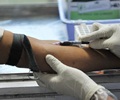The transcription factor FOXO3 may protect against alcohol-induced liver injury, according to a new study.

"There is emerging evidence that the FOXO transcription factor family plays a critical role in metabolic, antioxidant, and cell death responses in the liver. The role of FOXO in injury processes is complex as FOXO transcription programs can either be cytoprotective or cytotoxic, and well-documented examples of both phenomena are numerous," says Steven A. Weinman, MD, PhD, Department of Internal Medicine at the University of Kansas Medical Center.
Based on such emerging evidence, Dr. Weinman's group fed alcohol to FOXO3-deficient mice for three weeks. One third of these mice developed severe hepatic steatosis (infiltration of liver cells with fat), neutrophil infiltration, and necrosis, similar to that seen in patients with alcoholic hepatitis. In some mice, levels of the liver enzyme alanine aminotransferase (ALT) increased tenfold compared to controls.
Investigators also induced severe liver injury with alcohol in a mouse model of HCV (transgenic HCV/Sod2+/-). These animals had elevated ALT; increased ICAM-1 expression and caspase 3 cleavage, and severe steatosis, lobular inflammation, and ballooning degeneration of liver cells. In these mice, degree of liver injury correlated with levels of the mitochondrial antioxidant enzyme superoxide dismutase (SOD2). (SOD2 is also thought to play a part in protecting the liver from alcoholic injury.) Alcohol-treated HCV/Sod2+/- mice also showed a greater concentration of FOXO3 in the cytosol of the cell compared to the nuclear location found in other types of mice.
Weinman continues, "One of the important unanswered questions about alcoholic liver disease has been why only a minority of those who drink, including those who drink heavily, ever develop liver disease. In most people, the liver has efficient protection mechanisms against alcohol. Our results indicate that FOXO3 is a novel alcohol protection factor that is disrupted by the HCV-alcohol combination. We therefore think that modulation of the FOXO3 pathway is a potential therapeutic approach for HCV-alcohol-induced liver injury."
In cell culture, either HCV or alcohol alone produced an increase in FOXO3 transcriptional activity. However, Weinman and colleagues found that although the effects of both of these stress stimuli on FOXO3 were similar, the mechanisms of action were different. For example, although HCV activation was associated with translocation of FOXO3 from cytosol to the nucleus, alcohol produced transcriptional activation without a prominent change in the nuclear-cytosolic ratio. Another difference found was that HCV, but not alcohol, caused a miRNA-dependent suppression of SOD2 translation.
Advertisement
In the same issue of The American Journal of Pathology, another team of investigators from the University of Kansas Medical Center, led by Dr. Wen-Xing Ding, PhD, Department of Pharmacology, Toxicology, and Therapeutics, also report that FOXO3 protects against acute ethanol-induced steatosis and liver injury. This study demonstrates that FOXO3 is necessary for activation of autophagy, a cellular degradation pathway that protects against alcohol-induced liver injury by removing damaged mitochondria. Acute alcohol-treated FOXO3-deficient mice developed more severe liver injury than that of wild-type mice, and this was attributed to decreased expression of autophagy-related genes.
Advertisement
Source-Eurekalert















